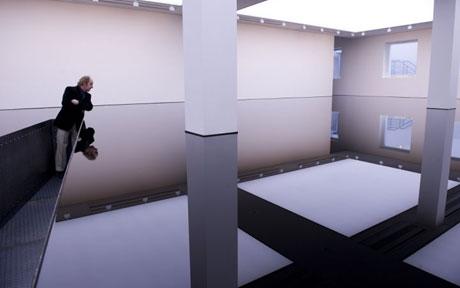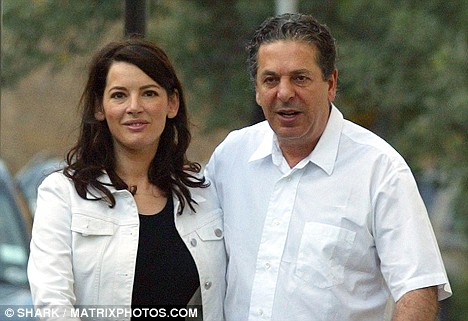
Richard Wilson, "20:50" at the Saatchi Gallery
Let us assume there are two boxes on a table. In one box, there is a relatively normal turtle; in the other, Adolf Hitler’s skull. You have to select one of these items for your home. If you select the turtle, you can’t give it away and you have to keep it alive for two years; if either of these parameters are not met, you will be fined $999 by the state. If you select Hitler’s skull, you are required to display it in a semi-prominent location in your living room for the same amount of time, although you will be paid a stipend of $120 per month for doing so. Display of the skull must be apolitical.
— Chuck Klosterman, “23 Questions I Ask Everybody I Meet In Order To Decide If I Can Really Love Them”
There’s a leaning tower of literature on the sociology of gift-giving that can probably be best summarized in Chuck Klosterman’s quote above. Call it the Hitler’s Skull Syndrome. The giving of any significant gift – a teal-and-lemon diamond-pattern golf sweater with sewn-in turtleneck, say, or a large art bequest to the nation — involves the unwitting signing of a binding contract you didn’t know existed. Now every time my uncle Gunther comes over, I have to wear that sweater and pretend it doesn’t chafe my armpits. And now Charles Saatchi has given his collection – over 200 works of art, plus a white-walled central London gallery to house it in, plus a full quota of exceptionally competent staff – to the nation. And while it might not be that surprising to find Hitler’s skull actually on display in Saatchi’s gallery – perhaps coated in gold leaf on a spotlit plinth – it’s one of those gifts that, like the skull or the sweater, pre-emptively determines its own reception.
“To the nation,” “for the nation,” “by the nation.” In Britain, things are always being done to the nation, as though the nation were a vegetative octogenarian unable to make its own decisions about anything. “It’s for your own good,” say the national institutions, casting a simpering smile at the drooling, quivering figure strapped to the bed, while they fork out a billion of public money on a rare Raphael doodle. “The nation” is an undifferentiated mass of passive receivers, happy to gobble up whatever it’s thrown. The notion of national gifting becomes a questionable idea when the art itself has barely any foothold within the national imagination (it’s a bit more complex with, say, the Elgin Marbles – sorry, Parthenon Frieze), but when the gift is this enormous, this absolute (all costs will be covered by Saatchi himself, not the taxpayer), this tried-and-tested popular, it’s hard to remain septical, right?
Yes and no. The gift itself includes works of differing quality (Tracey Emin’s regretfully renowned My Bed on one hand, the Chapmans’ mad masterpiece Tragic Anatomies on the other) with little of the visual panache with which Saatchi and his voracious appetite is associated. So there’s no shark in a tank, no blood-head, no child murderers, no bifurcated bovines. All that is scattered throughout private collections across the world, having been offloaded in customary style a few years ago. So the gallery will not become a monument to an historical moment, that of the YBAs with whom he’s most closely linked; rather, it will be a monument to an eye. But, as Cezanne said of Monet, “he’s only an eye, but my God, what an eye.”
Saatchi’s adman taste has softened of late – the current show at the Saatchi Gallery, Newspeak, features some unexpectedly reserved and resonant work by Hurvin Anderson, Rupert Norfolk and Phoebe Unwin – but there’s no questioning his ability to marshal the disordered melee of contemporary art into a language of high-impact, snappily visual work that suggests a school that doesn’t really exist. The title of his art reality show – School of Saatchi – looks set to become an ‘ism of our time, and for better or worse, one man’s ten-second-pitch attitude has become the benchmark for what much art looks like now, and has created an audience for contemporary art which never knew it was.
But Saatchi’s collection is by no means definitive, whatever its status within the public imagination suggests. If you review the shows that have been on display at the Saatchi Gallery since its opening, the focus has been seriously tipped towards painting and assemblage/sculpture; there’s been very little or no photography, video or performance work. This has been Saatchi’s poisoned chalice — he can’t help his collection being seen as definitive (it’s many people’s definition of what contemporary art is), but he also can’t help it being media-friendly, because that’s his background and the nature of his taste. It’s always been YBA art’s biggest virtue and its biggest weakness that it is so transferrable into print media. It came to prominence in the final blaze of significance for print media, and that its demise is so passionately rued in that very context is surely no accident.

Nigella Lawson and Charles Saatchi
The patchiness of Saatchi’s taste isn’t a problem under the gallery’s current name. Here’s where the gift gets tricky, though (the sewn-in turtleneck part). Saatchi’s gift involves the renaming of the institution “Museum of Contemporary Art London” or, confusingly, MoCA London (note to institutions: the only person allowed to mix capitals is Johnny PayCheck, and he’s dead). And it’s hard not to read this as a deliberate alternative to London’s current museum of contemporary art, Tate Modern, like calling your band The Winsome Moaners and expecting Coldplay not to be upset. Saatchi’s relationship to the Tate institution is a complex one. His 1997 show, Sensation, certainly laid the metaphorical foundations for Tate Modern, and yet none of the works associated with that show are in the collection of the Tate. One might argue that the lack of YBA work (with few exceptions) in the Tate collection, as well as the creation of sister museum Tate Britain in 2000, engendered Tate Modern’s current remit of determinedly international contemporary art. It’s certainly hard to picture the Chapmans’ installation, or Emin’s bed, fitting seamlessly into the rather austere curatorial approach of the Tate. Walking through the permanent collection, it’s easy to assume the YBAs were a bad dream and British art stopped when Francis Bacon died. And the oft-repeated story that Saatchi offered works from his collection to Tate director Sir Nicholas Serota, who flatly refused, lends anecdotal credibility to the idea that the YBAs are seen, in some quarters, as a sort of national embarrassment, like our football team or film industry or pretty much anything else.
Saatchi’s gift is an extraordinarily generous one, and its inflexibility (as compared, say, to Anthony d’Offay’s bequest, now interspersed in Tate Modern and other British galleries) is of a piece with the collector’s public image as a taciturn crowd-pleaser with a God complex and a lovely wife. The news appears as Britain’s national galleries are in a floundering position. The coalition government is threatening the introduction of entry charges to museums such as the National Gallery and British Museum, rendering the idea of “the nation” somewhat more exclusive. And London’s non-profit contemporary art spaces seem shot through with a similar insecurity. The Serpentine, the least surprising art gallery in London, is waning in significance; the Hayward is wayward, plumping for lifeless participation (the current, terrible, Ernesto Neto show) over quality programming (the Mark Wallinger and Annette Messager shows of a couple of years back); and the Tate itself can suffer from cramped curatorial theses and an overtly academic attitude (the current, oddly boring show Exposed is a case in point).
If MoCA London is to be a viable alternative to these places, it’ll need to play to its strengths. Its galleries, clearly pitched towards the display of painting, will need to drop their finicky cleanliness and engage with a much wider range of media. The location, deep in the heart of tweed-and-sheik country, is a disadvantage, but an imaginative education program might well solve that. While Tate Modern can suck the life out of a monographic painting show (in-depth solo shows by Per Kirkeby, Barnett Newman, and Cy Twombly are a few of many examples), MoCA London could do what the Royal Academy does well and show a single painter’s work in depth — in other words, show loan exhibitions rather than sticking to the one-collector remit. Isn’t it about time for a Richard Diebenkorn retrospective? Or Joan Mitchell? Or Robert Ryman? Provided Saatchi is prepared to go against his instincts and relinquish the reins of power, this could be the thing you’ve always wanted.

Hitler's skull, yesterday




Pingback: Artist News » Letter from London: Tense Present | Art21 Blog